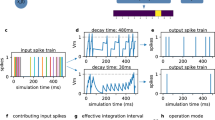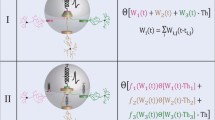Abstract
Do cortical neurons operate as integrators or as coincidence detectors? Despite the importance of this question, no definite answer has been given yet, because each of these two views can find its own experimental support. Here we investigated this question using models of morphologically-reconstructed neocortical pyramidal neurons under in vivo like conditions. In agreement with experiments we find that the cell is capable of operating in a continuum between coincidence detection and temporal integration, depending on the characteristics of the synaptic inputs. Moreover, the presence of synaptic background activity at a level comparable to intracellular measurements in vivo can modulate the operating mode of the cell, and act as a switch between temporal integration and coincidence detection. These results suggest that background activity can be viewed as an important determinant of the integrative mode of pyramidal neurons. Thus, background activity not only sharpens cortical responses but it can also be used to tune an entire network between integration and coincidence detection modes.
Similar content being viewed by others
References
Abeles M (1982) Role of the cortical neuron: Integrator or coincidence detector? Isr. J. Med. Sci. 18: 83-92.
Abeles M, Bergman H, Margalit E, Vaadia E (1993) Spatiotemporal firing patterns in the frontal cortex of behaving monkeys. J. Neurophysiol. 70: 1629-1638.
Aertsen A, Diesmann M, Gewaltig MO (1996) Propagation of synchronous spiking activity in feedforward neural networks. J. Physiology (Paris) 90: 243-247.
Bair W, Koch C (1996) Temporal precision of spike trains in extrastriate cortex of the behaving macaque monkey. Neural Computation 15: 1185-1202.
Barlow H (1995) The neuron doctrine in perception. In: MS Gazzaniga, ed. The Cognitive Neurosciences. MIT Press. pp. 415-435.
Bell CC, Han VZ, Sugawara Y, Grant K (1997) Synaptic plasticity in a cerebellum-like structure depends on temporal order. Nature 387: 278-281.
Bernander Ö, Douglas RJ, Martin KAC, Koch C (1991) Synaptic background activity influences spatiotemporal integration in single pyramidal cells. Proc. Natl. Acad. Sci. USA 88: 11569-11573.
Bi GQ, Poo MM (1998) Synaptic modifications in cultured hippocampal neurons: Dependence on spike timing, synaptic strength, and postsynaptic cell type. J. Neurosci. 18: 10464-10472.
Bugmann G, Christodoulou C, Taylor JG (1997) Role of temporal integration and fluctuation detection in the highly irregular firing of a leaky integrator neuron model with partial reset. Neural. Comp. 9: 985-1000.
Buzsaki G, Horvath Z, Urioste R, Hetke J, Wise K (1992) High-frequency network oscillation in the hippocampus. Science 256: 1025-1027.
Contreras D, Destexhe A, Steriade M (1997) Intracellular and computational characterization of the intracortical inhibitory control of synchronized thalamic inputs in vivo. J. Neurophysiol. 78: 335-350.
deCharms RC, Merzenich MM (1996) Primary cortical representation of sounds by the coordination of action-potential timing. Nature 381: 610-613.
deCharms RC, Zador A (2000) Neural representation and the cortical code. Annu. Rev. Neurosci. 23: 613-647.
DeFelipe J, Fariñas I (1992) The pyramidal neuron of the cerebral cortex: Morphological and chemical characteristics of the synaptic inputs. Prog. Neurobiol. 39: 563-607.
Destexhe A, Mainen ZF, Sejnowski TJ (1998) Kinetic models of synaptic transmission. In: C Koch, I Segev, eds. Methods in Neuronal Modeling, 2nd edn. MIT Press, Cambridge, MA. pp. 1-26.
Destexhe A, Paré D (1999) Impact of network activity on the integrative properties of neocortical pyramidal neurons in vivo. J. Neurophysiol. 81: 1531-1547.
Diesmann M, Gewaltig MO, Aertsen A (1996) Characterization of synfire activity by propagating “pulse packets.” In: JM Bower, ed. Computational Neuroscience. Academic Press, San Diego. pp. 59-64.
Diesmann M, Gewaltig MO, Aertsen A (1999) Stable propagation of synchronous spiking in cortical neural networks. Nature 402: 529-533.
Engel AK, König P, Kreiter AK, Schillen TB, Singer W (1992) Temporal coding in the visual cortex: New vistas on integration in the nervous system. Trends Neurosci. 15: 218-226.
Gerstein GL, Bedenbaugh P, Aertsen AMHJ (1989) Neuronal assemblies. IEEE Trans. Biomed. Eng. 36: 4-14.
Gray CM (1994) Synchronous oscillations in neuronal systems: Mechanisms and functions. J. Comput. Neurosci. 1: 11-38.
Han VZ, Grant K, Bell CC (2000) Reversible associative depression and nonassociative potentiation at a parallel fiber synapse. Neuron 27: 611-622.
Häusser M, Spruston N, Stuart GJ (2000) Diversity and dynamics of dendritic signaling. Science 290: 739-744.
Hines ML, Carnevale NT (1997) The NEURON simulation environment. Neural Computation 9: 1179-1209.
Hô N, Destexhe A (2000) Synaptic background activity enhances the responsiveness of neocortical pyramidal neurons. J. Neurophysiol. 84: 1488-1496.
Hodgkin AL, Huxley AF (1952) A quantitative description of membrane current and its application to conduction and excitation in nerve. J. Physiol. 117: 500-544.
Holmes WR (1986) Cable theory modeling of the effectiveness of synaptic inputs in cortical pyramidal cells. Ph.D. Thesis, University of California, Los Angeles.
Holt GR, Softky WR, Koch C, Douglas RJ (1996) Comparison of discharge variability in vitro and in vivo in cat visual cortex neurons. J. Neurophysiol. 75: 1806-1814.
Huguenard JR, Hamill OP, Prince DA (1988) Developmental changes in Na+ conductances in rat neocortical neurons: Appearance of a slow inactivating component. J. Neurophysiol. 59: 778-795.
Johnston D, Magee JC, Colbert CM, Christie BR (1996) Active properties of neuronal dendrites. Annu. Rev. Neurosci. 19: 165-186.
Kisley MA, Gerstein GL (1999) The continuum of operating modes for a passive model neuron. Neural Comp. 11: 1139-1154.
Koch C, Laurent G (1999) Complexity and the nervous system. Science 284: 96-98.
König P, Engel AK, Roelfsema PR, Singer W (1995) How precise is neuronal synchronization? Neural Comp. 7: 469-485.
König P, Engel AK, Singer W (1996) Integrator or coincidence detector? The role of the cortical neuron revisited. Trends Neurosci. 19: 130-137.
Kretzberg J, Egelhaaf M, Warzecha A-K (2001) Membrane potential fluctuations determine the precision of spike timing and synchronous activity: A model study. J. Comp. Neurosci. 10: 79-97.
Krüger J, Becker JD (1991) Recognizing the visual stimulus from neuronal discharges. Trends Neurosci. 14: 282-286.
Lábos E (2000) Codes, operations, measurements and neural networks. Biosystems 58: 9-18.
Larkman AU (1991) Dendritic morphology of pyramidal neurons of the visual cortex of the rat. III. Spine distributions. J. Comp. Neurol. 306: 332-343.
Lytton WW (1996) Optimizing synaptic conductance calculation for network simulations. Neural Computation 8: 501-509.
MacGregor RJ (1991) Sequential configuration model for firing patterns in local neural networks. Biol. Cybern. 65: 339-349.
Magee JC (2000) Dendritic integration of excitatory synaptic input. Nature Rev. Neurosci. 1: 181-190.
Mainen ZF, Sejnowski TJ (1995) Reliability of spike timing in neocortical neurons. Science 268: 1503-1506.
Marŝálek P, Koch C, Maunsell J (1997) On the relationship between synaptic input and spike output jitter in individual neurons. Proc. Natl. Acad. Sci. USA 94: 735-740.
McClurkin JW, Optican LM, Richmond BJ, Gawne TJ (1991) Concurrent processing and complexity of temporally encoded neuronal messages in visual perception. Science 253: 675-677.
Murthy VN, Fetz EE (1994) Effects of input synchrony on the firing rate of a three-compartment cortical neuron model. Neural Comp. 6: 1111-1126.
Noda H, Adey R (1970) Firing variability in cat association cortex during sleep and wakefulness. Brain Res. 18: 513-526.
Nowak LG, Sanchez-Vives MV, McCormick DA (1997a) Influence of low and high frequency inputs on spike timing in visual cortical neurons. Cereb. Cortex 7: 487-501.
Nowak LG, Sanchez-Vives MV, McCormick DA (1997b) Membrane potential trajectory preceding visually evoked action potentials in cat’s visual cortex. Soc. Neurosci. Abstr. 23: 14.
Panzeri S, Petersen RS, Schultz SR, Lebedev M, Diamond ME (2001) The role of spike timing in the coding of stimulus location in rat somatosensory cortex. Neuron 29: 769-777.
Panzeri S, Schultz SR (2001) A unified approach to the study of temporal, correlational, and rate coding. Neural Comp. 13: 1311-1349.
Panzeri S, Schultz SR, Treves A, Rolls ET (1999) Correlations and the encoding of information in the nervous system. Proc. R. Soc. Lond. B Biol. Sci. 266: 1001-1012.
Paré D, Shink E, Gaudreau H, Destexhe A, Lang EJ (1998) Impact of spontaneous synaptic activity on the resting properties of cat neocortical neurons in vivo. J. Neurophysiol. 79: 1450-1460.
Prut Y, Vaadia E, Bergman H, Haalman I, Slovin H, Abeles M (1998) Spatiotemporal structure of cortical activity: Properties and behavioral relevance. J. Neurophysiol. 79: 2857-2874.
Reinagel P, Reid RC (2000) Temporal coding of visual information in the thalamus. J. Neurosci. 20: 5392-5400.
Riehle A, Grün S, Diesmann M, Aertsen A (1997) Spike synchronization and rate modulation differentially involved in motor cortical function. Science 278: 1950-1953.
Rudolph M, Destexhe A (2001a) Correlation detection and resonance in neural systems with distributed noise sources. Phys. Rev. Lett. 86: 3662-3665.
Rudolph M, Destexhe A (2001b) Do neocortical pyramidal neurons display stochastic resonance? J. Comp. Neurosci. 11: 19-42.
Schwindt PC, CrillW E (1997) Local and propagated dendritic action potentials evoked by glutamate iontophoresis on rat neocortical pyramidal neurons. J. Neurophysiol. 77: 2466-2483.
Segundo JP (2000) Some thoughts about neural coding and spike trains. Biosystems 58: 3-7.
Segundo JP, Perkel DH, Moore GP (1966) Spike probability in neurones: Influence of temporal structure in the train of synaptic events. Kybernetik 3: 67-82.
Shadlen MN, Newsome WT (1994) Noise, neural codes and cortical organization. Curr. Opin. Neurobiol. 4: 569-579.
Shadlen MN, Newsome WT (1995) Is there a signal in the noise? Curr. Opin. Neurobiol. 5: 248-250.
Shadlen MN, Newsome WT (1998) The variable discharge of cortical neurons: Implications for connectivity, computation, and information coding. J. Neurosci. 18: 3870-3896.
Shinomoto S, Sakai Y, Funahashi S (1999) The Ornstein-Uhlenbeck process does not reproduce spiking statistics of neurons in prefrontal cortex. Neural Comput. 11: 935-951.
Smith DR, Smith GK (1965) A statistical analysis of the continuous activity of single cortical neurons in the cat unanesthetized isolated forebrain. Biophys. J. 5: 47-74.
Softky WR (1994) Sub-millisecond coincidence detection in active dendritic trees. Neuroscience 58: 13-41.
Softky WR (1995) Simple codes versus efficient codes. Curr. Opin. Neurobiol. 5: 239-247.
Softky WR, Koch C (1993) The highly irregular firing of cortical cells is inconsistent with temporal integration of random EPSPs. J. Neurosci. 13: 334-350.
Stein RB (1967) Some models of neuronal variability. Biophys. J. 7: 37-68.
Stevens CF, Zador AM (1998) Input synchrony and the irregular firing of cortical neurons. Nature Neurosci. 1: 210-217.
Stuart G, Spruston N, Sakmann B, Häusser M (1997) Action potential initiation and backpropagation in neurons of the mammalian CNS. Trends Neurosci. 20: 125-131.
Theunissen F, Miller JP (1995) Temporal encoding in nervous systems: A rigorous definition. J. Comput. Neurosci. 2: 149-162.
Tovée MJ, Rolls ET, Treves A, Bellis RP (1993) Information encoding and the responses of single neurons in the primate temporal visual cortex. J. Neurophysiol. 70: 640-654.
Traub RD, Miles R (1991) Neuronal Networks of the Hippocampus. Cambridge University Press.
Troyer TW, Miller KD (1997) Physiological gain leads to high ISI variability in a simple model of a cortical regular spiking cell. Neural. Comp. 9: 971-983.
Tsodyks MV, Sejnowski T (1995) Rapid state switching in balanced cortical network models. Network 6: 111-124.
Usher M, Stemmler M, Koch C, Olami Z (1994) Network amplification of local fluctuations causes high spike rate variability, fractal Tuning Neocortical Pyramidal Neurons 251 firing patterns and oscillatory local field potentials. Neural. Comp. 6: 795-836.
Vaadia E, Haalman I, Abeles M, Bergman H, Prut Y, Slovin H, Aertsen A (1995) Dynamics of neuronal interactions in monkey cortex in relation to behavioural events. Nature 373: 515-518.
van Vreeswijk C, Sompolinsky H (1996) Chaos in neuronal networks with balanced excitatory and inhibitory activity. Science 274: 1724-1726.
White EL (1989) Cortical Circuits. Birkhauser. Boston.
Zohary E, Shadlen MN, Newsome WT (1994) Correlated neuronal discharge rate and its implications for psychophysical performance. Nature 370: 140-143.
Author information
Authors and Affiliations
Rights and permissions
About this article
Cite this article
Rudolph, M., Destexhe, A. Tuning Neocortical Pyramidal Neurons between Integrators and Coincidence Detectors. J Comput Neurosci 14, 239–251 (2003). https://doi.org/10.1023/A:1023245625896
Issue Date:
DOI: https://doi.org/10.1023/A:1023245625896




